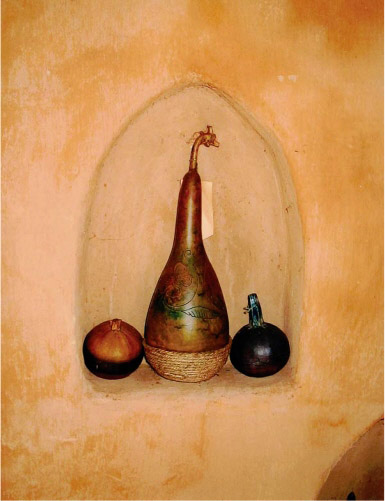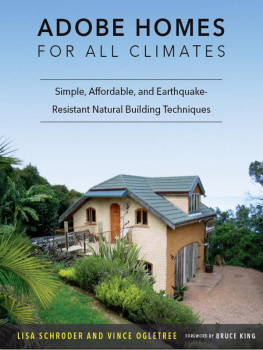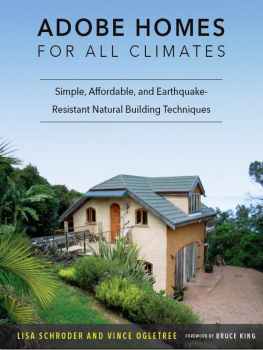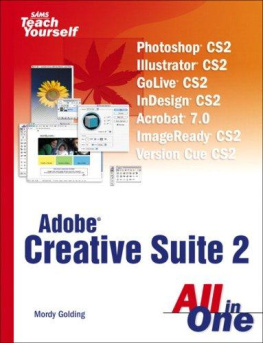ADOBE HOMES
FOR ALL CLIMATES

ADOBE HOMES
FOR ALL CLIMATES
_________________
Simple, Affordable, and Earthquake
Resistant Natural Building Techniques
_________________
LISA SCHRODER
AND
VINCE OGLETREE
C HELSEA G REEN P UBLISHING
W HITE R IVER J UNCTION, V ERMONT
Copyright 2010 by Adobe Building Systems, LLC
All rights reserved.
No part of this book may be transmitted or reproduced in any form by any means without permission in writing from the publisher.
Project Manager: Patricia Stone
Developmental Editor: Jonathan Teller-Elsberg
Copy Editor: Cannon Labrie
Proofreader: Nancy Ringer
Designer: Peter Holm, Sterling Hill Productions
Photographs and illustrations by Lisa Schroder or Vince Ogletree unless otherwise noted
Printed in the United States of America
First printing August, 2010
10 9 8 7 6 5 4 3 2 1 10 11 12 13 14
Our Commitment to Green Publishing
Chelsea Green sees publishing as a tool for cultural change and ecological stewardship. We strive to align our book manufacturing practices with our editorial mission and to reduce the impact of our business enterprise in the environment. We print our books and catalogs on chlorine-free recycled paper, using vegetable-based inks whenever possible. This book may cost slightly more because we use recycled paper, and we hope youll agree that its worth it. Chelsea Green is a member of the Green Press Initiative (www.greenpressinitiative.org), a nonprofit coalition of publishers, manufacturers, and authors working to protect the worlds endangered forests and conserve natural resources.
Library of Congress Cataloging-in-Publication Data
Schroder, Lisa, 1975
Adobe homes for all climates : simple, affordable, and earthquake-resistant natural building techniques / Lisa Schroder and Vince Ogletree.
p. cm.
eBook ISBN: 978-1-60358-282-7
1. Adobe houses. 2. Building, Adobe. 3. Architecture and climate. 4. Earthquake resistant design. I. Ogletree, Vince, 1964-2005. II. Title.
TH4818.A3S37 2010
690.8--dc22
2010019056
Chelsea Green Publishing Company
Post Office Box 428
White River Junction, VT 05001
(802) 295-6300
www.chelseagreen.com
CONTENTS
Dedication
In loving memory of Vince Ogletree
19642005
So, it took us thousands of years to get out of these mud huts.
Why would we want to get back into them?
The woman who asked me this was gracious, warm, and deliberately provocative, posing exactly the question that her radio audience would have raised. It was a dreary, gray morning in 1997 in Belfast, North Ireland. I had just been ushered into the studios of BBC Radio, fresh off the plane from California, to promote a new book on earth-and-straw buildings. Hoping to draw more people in for a talk that evening at Queens University, this five-minute interview had been arranged so that we could reach the morning commuters. After a breezy weather report (Looks like another cold, wet one, Belfast!), my host turned to me and, with a fast introduction and huge smile, asked the question that most everyone asks about adobe houses: Why would we want to get back into them?
I really dont remember how I replied on that live radio show, but in 1997 the revival of interest in modern earthen building was just getting started, a small footnote to the slowly growing interest in green or ecological building. Now, thirteen years later, there are handsome new structures on every continent made from adobe, pressed block, cob, and rammed earth, with new hybrid systems appearing to suit specific climates and conditions. An adobe home in Santa Barbara is the most comfortable Ive ever known, and built to the most demanding seismic standards anywhere. Rammed earth, introduced to California by the Chinese immigrants who came with the gold rush, is now the material of choice for multimillion-dollar mansions. Engineers in California, Peru, India, New Zealand, and other places have carefully worked out the details and procedures that make earthen structures durable, comfortable, and especially safe against earthquake forces. Materials scientists have studied earthen building (which really means clay-based construction), and catalogued the properties that any designer needs to design with confidence. A thick earthen wall can maintain thermal comfort and stabilize humidity, not just in sunny New Mexico, but just about anywhereand where the climate is a bit extreme, add a layer of insulation and youll be as comfortable as can be. Builders around the world have revived, and in many ways improved upon, these ancient building systems that most of our ancestors used when the very notion of permanent housing was still taking hold in human culture.
Adobe is back, bigger and better than ever before. Its not your distant ancestors mud hut, and neither is it the earthen home of your grandfather or father: this is adobe for the twenty-first century, courtesy of Lisa Schroder and Vince Ogletree. With Adobe Homesfor All Climates they add a fresh, modern voice to the lively revival of earthen building and provide you with a wealth of practical detail as well. People who are considering building with earthor just wondering why we would want to get back into themwould do well to consult this book.
As that cold, gray day in Belfast drew to a close, I entered an old, wood-paneled lecture hall where a large crowd had gathered to hear about alternative ways to build. We talked about rammed earth, adobe, straw bales, bamboo, and many other alternatives to the industrialized architecture that has taken over so much of the world. We talked about the warmth, both visual and actual, provided by natural materials, and the satisfaction that comes with helping to build your own home. As the questions wound down, a last hand appeared at the back of the crowded room. A sunburned old farmer stood up in his dungarees and faded shirt, and, with a voice trembling with emotion, told us his story. He told us he lived in the house he was born in, and that his father and grandfather and great grandfather had been born in, which was made of earthen walls with a thatched roof. It had served his family for at least two centuries, and besides having great sentimental value, was still perfectly livable. But the authorities had decreed otherwise, and ordered him to replace it with a modern building of concrete block. With a look of complete exasperation, he asked what he could do to change their minds. The whole room paused in silence, sensing his dismay and sharing frustration at the modern industrial juggernaut that brings many good things, but also crushes a few in its path. Sorry to say I had little to offer him back then in 1997, but as soon as someone invents a time machine I will hustle on back with a copy of Adobe Homes and say Here you go! Give this to everyone around you, and enjoy your earthen home for another two hundred years!
May you, too, reader, enjoy your copy of AdobeHomes, and the house I hope youll build for this and many, many generations to come. And to you, Lisa and Vince, thanks for a great book, and heres mud in your eye!
BRUCE KING
July 6, 2010
ADOBE HOMES
FOR ALL CLIMATES
ONE
Introduction
T oday, when people hear the word adobe they most often think of the software company behind the ubiquitous Acrobat PDF files and Photoshop image editor. However, the term has been in constant use for thousands of yearsits original meaning is brick or sticky paste. Adobe building is rich in history and usages.













